
 Click here for more information on the CJRRU- ATA |
Casey Jones Rail Road Unit of the ATA
TRAINS on POSTAL STATIONERY
by Bill Senkus
The following article is based on one I published originally in the November-December, 2002 issue of The Dispatcher, the journal of the Casey Jones Rail Road Unit of the ATA. I have taken advantage of the greater space available here to expand on both the text and image content, and plan to revise and expand as I learn more, and as time permits.
TRAINS ON POSTAL STATIONERY
By Bill Senkus
Click here for my list of all the rail-related postal stationery I know of, with scans.
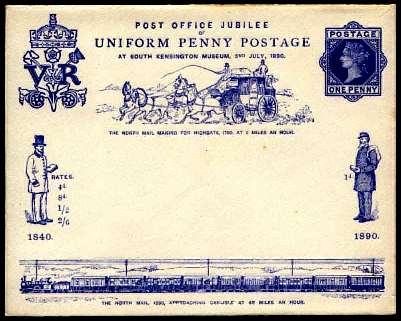
H&G A10
Twenty-eight percent of CJRRU members say they collect Trains on Postal Stationery, and I am among them, so I am offering this article as an overview of the area.
First, what is Postal Stationery? Well, the official definition of the term is simply "any stationery item provided by a postal administration," but I think most of us limit ourselves to the items that include an indicium (pre-paid postage). That includes stamped envelopes, postal cards, letter sheets, letter cards, aerogrammes, and wrappers. There is a Postal Stationery catalog, the Higgins & Gage, though most of it has not been updated for over 20 years. For pre-1980 material, however, it is still the bible, and items it covers are generally identified by their H&G numbers. I give those below when known.
Train in Indicium
Some Postal Stationery has a rail philatelic theme, either in the indicium, or in some other part of its design. If the rail theme is incorporated into the indicium, I think most of us would agree, that item has a legitimate place in a rail philatelic collection. Below is an example of such an item, a postal card from Guatemala, issued in 1921, H&G 13. The indicium (see enlargement) shows a steam train crossing the Las Vacas Viaduct. (This scene was later depicted from another angle on a stamp, Scott C765, in 1983.)

H&G 13

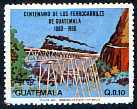
H&G 13 detail ------------ C765
The Las Vacas Viaduct, completed in 1907, is considered one of the major rail achievements of its era. Located just outside Guatemala City, it spans the Las Vacas river, and was built to carry trains of the Guatemala Railway. With a length of 743 feet and a height of 229 feet, it has a single, narrow-gauge track, and still carries traffic today, as you can see on this wonderful page of photographs from February, 2001: http://www.le-rail.ch/text/projekt40.htm. Look around on that site, it's a real treat for the rail enthusiast.
Here's an interesting anecdote about the viaduct, from the excellent site of Rinbad in the UK. (I'll leave it to you to find their explanation of their name.)
BLN 721.013][GT] Ferrocarriles de Guatemala: The 914mm-gauge nationalised FEGUA was formerly part of the IRCA, the International Railways of Central America, built by US interests to aid what the British would have called colonial development, including large- scale growing of bananas (whence the derogatory term 'banana republic'). Like many Latin American railways it faces an uncertain future. Guatemala's terrain, with young folded mountains still being formed, and several active volcanoes, is largely unfriendly to rail, necessitating slow climbs up steep and sinuous tracks and across valleys on magnificent tall trestles. The railway may draw photographers from the USA and Europe, but finds it hard to attract ordinary travellers, or shippers of import and export containers, away from the country's new roads. Remaining rail traffic seems sparse. On a November 1993 three-day visit with charter steam trains, no actual sign was seen of the few scheduled passenger workings supposed still to operate. A diesel-hauled mixed consist seen trailing a single almost empty and unglazed coach into a crossing loop may have been a 'way and works' maintenance train. Working practices are fairly informal. One steam special, reversing for photographic purposes on to the high-trestle Puente de las Vacas on the edge of Guatemala City, found that an unexpected diesel-hauled freight, said to be from Puerto Barrios on the Caribbean coast some 318km away, had been following, and seemed to want to use the single-track bridge at the same time! And rolling down the streets of Guatemala City's red-light district at dusk behind a 2-8-2 with the US chime whistle continuously sounding is also a kind of railtouring experience not yet on offer on any UK preserved line.
(From archived page http://www.avoe05.dsl.pipex.com/1994.txt)
Here is another postal card with a train in its stamp, from a set of ten issued by Switzerland in 1947 to celebrate the centenary of trains in that country. Each of the ten cards has the same indicium, but depicts on the left a different scene from a train station. (H&G 229?)
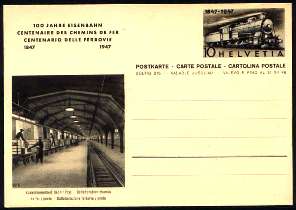

H&G 229?
Finding all ten of these may take some work - I just completed my set, after several years of searching, and I have just been informed that there were two printings, differing in the size of the inscription - 40mm vs. 44mm, so for the specialist there are 20 items. I think I am content with my 10.
Train in Supplementary Design Element
Next we have officially issued items on which the indicium does not have a train theme, but some other design element does, AND the indicium and design are a single unit. I think most rail collectors would consider these legitimate, collectible items. Here is one of my personal favorites, a postal card from Belgium, H&G 1, issued in 1872. Note the steam locomotive emerging from behind the figure on the left in the enlargement.
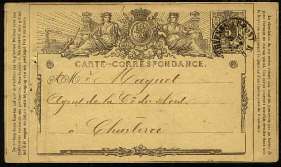
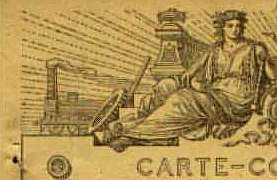
Or how about the set of six aerogrammes issued by Great Britain in 1996, all with the same generic indicium, but each showing famous locomotives of one of the major steam era rail companies in GB - here's one of those:
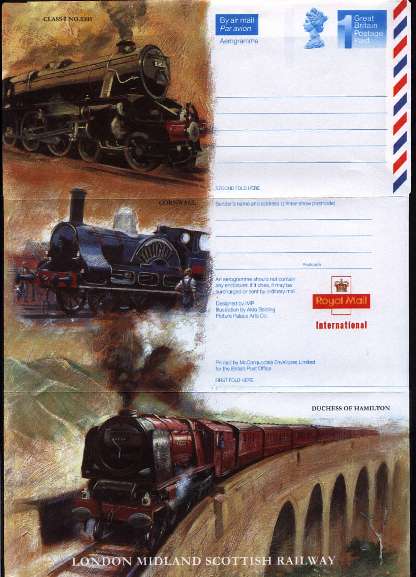
Train in Added Design Element - Advertising
What if the indicium does not depict a train, and the rail theme is part of some other design element printed on the item, AND that other element is not clearly a part of the item as officially issued?
That question raises one of the key issues in categorizing postal stationery as rail-thematic. How does one know whether any additional design elements were part of the original product, or something added later, by someone other than the postal authority that produced the basic item? Anyone can add a cachet and/or text to an envelope or postal card, and many companies, organizations, and individuals have done so, to advertise a product or event, or to create a collectible such as a First Day Cover, Event Cover, or Advertising Cover. To me items of that sort, modified from their original form by someone other than the postal authority, fall into a separate category from the subject of this article. Distinguishing them from legitimate postal issues can be tricky, though. Below is what appears to be such an item, a postal card from Belgium, issued in 1976, to which an ad for half-price commuter train tickets has been added. Was it part of the original printing, or added privately by the advertiser?
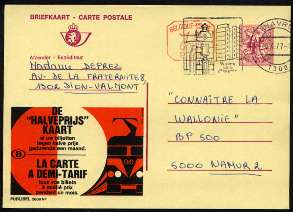
A little research among CJRRU members revealed that the item above has official status.
Note the text "Publibel 2609 NF" in the bottom left corner. That is a code assignd by
the Belgian postal service, to advertisers who wish to issue cards such as this. They go
back to the 1920's, and are printed and sold by the Belgian postal service. Here is the
full explanation, as supplied by CJRRU member Yannick Delaey of Belgium:
Any company can make a request to Belgium Post for
such cards. The requester must provide text and pictures for the advertising wanted.
Belgium Post assigns the unique Publibel number to each design.
The paper used to print the documents is the
property of Belgium Post, which gives it to a specialized printing company working for
the postal authorities. The printing company will print a limited number of copies of
the advertisement for the requester to review and approve.
At this point there is no postal value on the cards,
and while some are stamped with the word "annule" (specimen=proof), others are
not. Such proof cards often reach the market and can be acquired through dealers and
auctions. Both types of preliminary cards have equal status as proofs.
Once the advertiser approves the layout of the
advertisement, the required quantity will be printed, still without postal value. The
result is given to Belgium Post, which adds the indicium and other official text and
markings, and distributes the cards to post offices for sale to the public. Unlike the
Japanese "echo" cards, Publibels are sold at full price; people simply like the designs.
Many cards have next to the Publibel number also the
characters 'N', 'F', 'NF' or 'FN'. This means that the card is issued in Dutch (N =
Nederlands), in French (F), or in both languages: 'NF' = Dutch at top, French at the
bottom; 'FN' = French at top, Dutch at the bottom.
Japan issues similar postal cards, called "Echo cards", with private advertising, but they are sold at a discount of 10% off their face value, to compensate users for allowing the ad on their mail.
Train in Added Design Element - Thematic cachets
What about official overprints or cachets on postal stationery? Russia and Romania both have issued literally thousands of these, and aim them at topical collectors - indeed, they are the primary form of envelope used in those countries. Many show trains. Other (mainly eastern European) countries have issued them as well. I enjoy collecting these, but put them in a special category, since many are hard to distinguish from private products, such as event covers, and I know of no reliable way to tell. Here are a couple, an envelope from Bulgaria, issued in 1967, showing a train emerging from the Veliko Turnovo tunnel; and one from Ukraine, issued in 1997, showing a steam train against a map, commemorating the 125th anniversary of the Uzhgorod-Chop Railway.
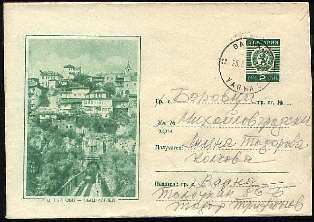
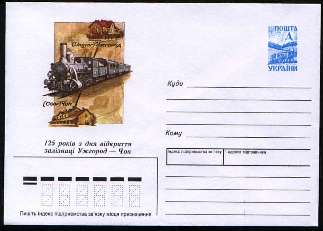
Each of these has a simple, generic indicium (with NO rail theme) that was used on multiple issues released over a period of months or even years, differing in the image and text printed at the left. The ones issued in Romania have an official number of the back, helping to confirm their official status. There is even a comprehensive catalog of the Romanian issues with a rail theme, produced by CJRRU member Hans Eriksson (see References, at bottom of page). In some cases, such as the item at the left above, the added design is printed with the same ink as the indicium, helping to prove the product was postally issued thus; but the status of items like the one on the right, independent of other evidence, is harder to determine.
Further complicating matters, some of these DO have a train in the indicium, and were then issued with many different cachets, most with no train element. Does one collect ALL of them? Or is one example enough?
Catalogs, Statistics, Conclusions ...
Unfortunately, there is no comprehensive catalog of rail-related postal stationery. The ATA Handbook does not try to list them. If you read the Introduction, you will see that the Handbook strives for completeness in postal stationery for only the US. It has a large, but by no means complete section on Romania. It mentions other items. But it is far from complete. I know of two special catalogs, one for rail-related items of Romania, and a general one for the USSR, 1927-34 (see below for details about both).
So how many rail-related items of postal stationery exist? Well, in preparation for this article, I scanned all the postal stationery in my own rail collection and found nearly 350 items from 50 countries; and I suspect there are many times that number more, simply because I have not worked that hard to acquire the ones I have.
2/13/2003 - The main thing I have learned in putting together this list is how little I knew about postal stationery. I now know, for example, that a complete collection would comprise at least 5,000 items. I hear that Hans Eriksson is working on new catalogs, though, so don't despair, help is on the way.
And what about the item shown at the start of this article? That's another old favorite of mine, a commemorative envelope issued in 1890 to celebrate the jubilee (50th anniversary) of Penny Postage in Great Britain. The text beneath the mail coach at top reads "The North Mail making for Highgate, 1790, at 8 miles an hour." The text beneath the steam train at the bottom reads "The North Mail, 1890, approaching Carlisle at 48 miles an hour."
Here are a few more favorites:
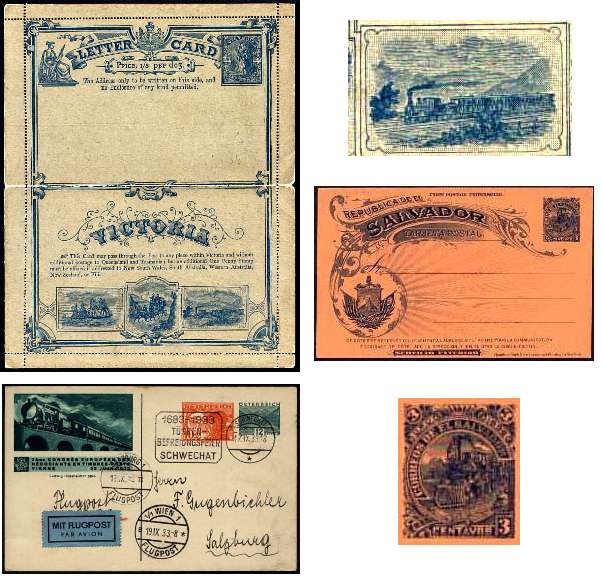
The letter card at top left was issued in Victoria, Australia, in 1880, H&G A1 - one of its vignettes shows a steam train - see the enlargement at top right. The postal card at center right was issued in El Salvador in 1896, H&G 31 - its indicium is enlarged at bottom right, and shows a steam locomotive. The same design was used on several stamps issued at the same time, e.g. Scott 161. The postal card at bottom left is one of a set of ten issued in Austria in conjunction with WIPA 1933, each with generic indicia of the time, with a vignette at the left depicting a mode of past, present, or future mail transport. Only this one shows a train. The designs were also printed on stamped envelopes, with varying indicia, and on a set of cinderellas. Technically they fall into the category "Printed To Private Order" (PTPO), so a purist would not call them official postal stationery.
Click here for my list of all the rail-related postal stationery I know of, with scans.
References and Resources
The Casey Jones Rail Road Unit of the American Topical Association (CJRRU-ATA) is one of the oldest study units of the ATA, and is devoted to the study of rail philately, or Trains on Stamps. If you would like to know more about us, please visit our web site.
World Railways Philatelic, by Norman E. Wright, Sr., ATA Handbook 138, published by the American Topical Association. This is available in printed format, in four parts, the main publication plus three supplements; and in CD-ROM format. See this web page for more information. It includes some information about postal stationery, but makes no attempt at present to be complete in that area. My listing on the pages starting with the link above include all the postal stationery items currently in the Handbook, EXCEPT for those of Romania. The Handbook includes a large, but by no means complete, listing of the Romanian issues.
Postal Stationery Associated with Railways, Romania, 1920-2000, by Hans Eriksson, published by the author, Stockholm, Sweden, 2001. According to the introduction, this is "a catalogue containing all postal stationery with railway, tram and aerial rope way motives" issued by Romania. With text in Swedish, English and German, it includes a concise but detailed listing of all items known to its author, comprising some 137 different postcards, 308 envelopes, 311 picture postal cards, and 95 receipt cards (plus many varieties) in the Railways and Tramways section, with illustrations of the earlier items that lack unique postal identifiers (Cod no). At the date I am publishing this (1/12/2003), the author reported that he still had copies for sale, for $17 plus $9 postage. Write him at Storvretsvägen 141, SE-16347 SPÅNGA, Sweden. Email: hans_eriksson00@hotmail.com
Hans Eriksson has published other catalogs, some for postal stationery only, some including both stamps and postal stationery, and some of these are still available. He plans to issue further catalogs like the one for Romania. Write him for more information.
Catalogue of Propaganda-Advertising Postal Cards of the USSR, 1927-34, by George V. Shalimoff and George B. Shaw, Edited by Jean R. Walton, published by the United Postal Stationery Society, October, 2002. I just acquired my own copy of this new publication, and while it covers only the 8 years named, and includes ALL material, not just those with trains, it is a magnificent accomplishment and an indispensable resource. The introductory section gives a detailed overview of the history of the area, and explains by implication why the USSR and other former Soviet bloc countries have produced so many different items of postal stationery with propaganda and commemorative designs. The topical index lists 17 items with a train theme, and 3 showing trolleys. Most important and gratifying of all, EVERY design listed is illustrated, and the reproductions are of excellent quality. The catalogue is available from the UPSS, and from many dealers.
CJRRU members Pat and Mel Feiner, dba Classic Philatelics, are the current publishers of the Higgins & Gage catalog of postal stationery, and have the most extensive stock of postal stationery I know of. Write them at PO Box 5637, Huntington Beach, CA 92615- 5637, ask for their trains list. Email: patmel at(@) sbcglobal.net
CJRRU member Al Peterson, dba The Rail Philatelist, has an extensive stock of rail philatelic material, including a lot of postal stationery. He has a web site at http://www.railphilatelist.com/, and publishes a very interesting and informative monthly newsletter, Al's Railings. Write him at The Rail Philatelist, P.O. Box 25505, Colorado Springs, CO 80936; or email him at RAILPHIL@aol.com
CJRRU member Bruce Hecht is the major East Coast rail philatelic dealer, with an extenive world-wide stock, including postal stationery. E-mail him at bhect@optonline.net, or write him at PO Box 474, New Hyde park, NY 11040.
Send feedback to the webmaster: CLICK HERE
Revised -- 02/20/2003
